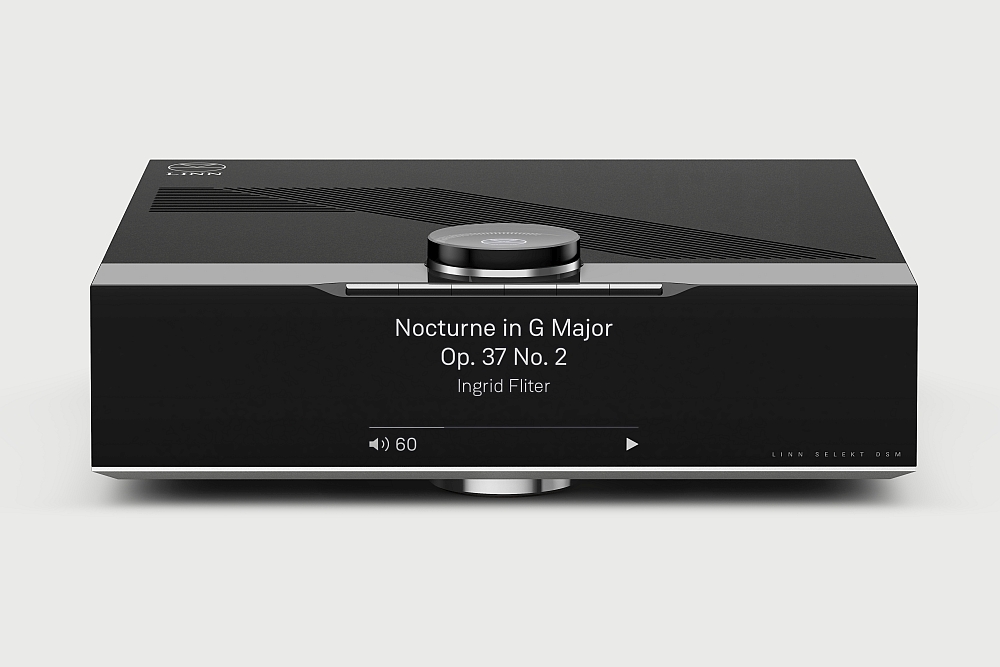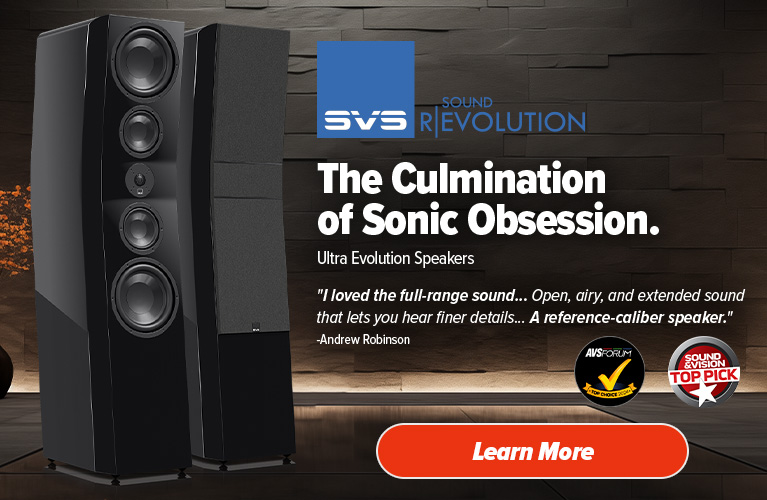Aside from your choice of speaker, it is, in most cases, the room that has the next biggest influence on the overall sound of your system. With the digital technology and processing power available today there’s almost no excuse for having to ‘put up with’ room imposed limitations to one’s audio system’s performance. Linn’s approach, called ‘Space Optimisation’, uses a mathematical approach to achieve the appropriate correction.
Correcting Digital
Trying as I have done to convince my wife to accept various types of physical room treatments (diffusers, absorbers and bass traps) I must admit to having been entirely unsuccessful. Your living space is, after all, supposed to look inviting to both your family and visitors so, unless you want to be tucked away in a purpose built room listening to tunes in isolation, some compromises have to be made. That’s where DRC or Digital Room Correction comes in. The traditional DRC solution involves measuring the acoustic parameters of the room using a microphone and applying frequency amplitude correction to room modes by cutting here and boosting there to balance the overall frequency response. Typically, this is done up to around 200 Hz which is where the most significant room modes exist. Linn’s proprietary methodology is called ‘Space Optimisation’ and uses a mathematical approach to achieve the appropriate correction. The signal is digitised at 24-bit/192kHz resolution and by using parameters such as the speed of sound, wavelengths and distances from the source to nearby reflective surfaces, Linn claims that they can predict very accurately what frequencies need adjustment, and by how much, to counter the deleterious effects of the room.
Linn believes that an acoustic measurement of the interactions between your speakers and room can have many sources of error which may affect the accuracy of the measurement. These include: the choice of measurement stimulus (MLS or a log chirp), external noise, quality, calibration and positioning of the microphone (which can be sensitive to within a few centimetres). Instead, Linn believes that the use of acoustic modelling removes these sources of error and thus has clear advantages over acoustic measurement in understanding the interactions between your speakers and room. Finally, Linn’s engineers understand the impact this has on the overall listening experience which is why their Space Optimisation technology is built into all Linn systems.
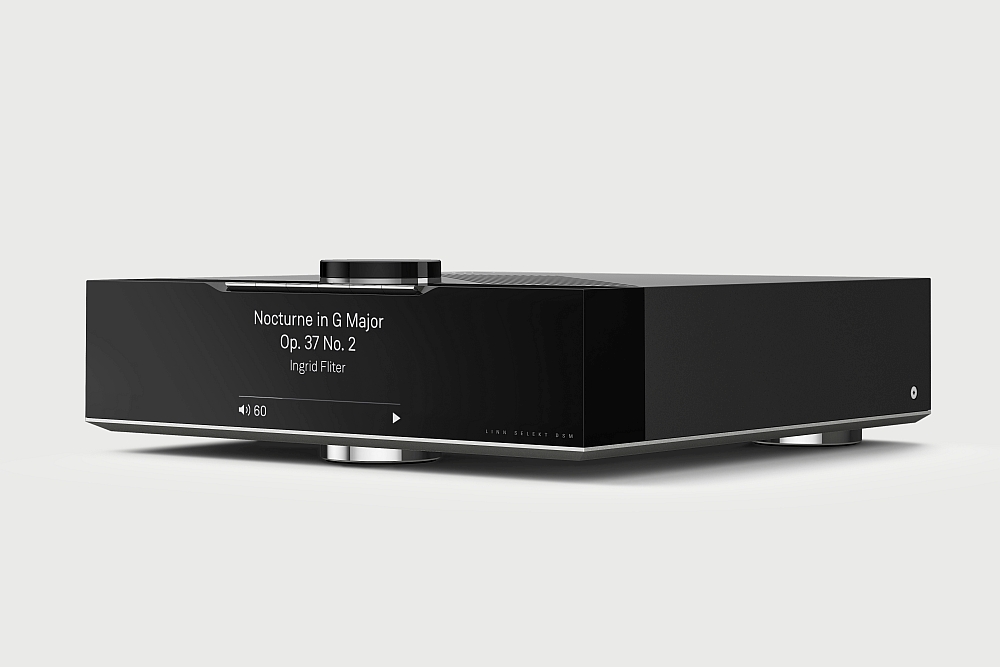
Enter the Selekt DSM. The Selekt’s modular design, build and finish, are extraordinary. The OLED display is super clear and perfectly sized so that it can be easily read from across the room. The unit features shock absorbing feet and a reassuringly solid feel. The glass control dial on top provides the user a tactile connection to the device.
Selecting Selekt
Linn’s Selekt sits in the range above Majik and below Akurate and Klimax and can be purchased in a number of configurations depending on your needs. The base model, the Selekt DSM is a network music player (streaming source, DAC and preamp) with built-in MM/MC phono stage. There are 2 x Toslink, 1 x USB (Class 2), and 2 x SPDIF digital inputs along with one set of analogue inputs. Upgrades can be done by adding what Linn calls ‘cartridges’, which are plug-in modules, that allow you to add the high-end DAC known as Katalyst and/or an integrated amplifier. There is also a 5.1 channel processor upgrade planned for 2019. These cartridge style upgrades are so simple they can be done in minutes at home (Linn always recommends that upgrades are carried out by a Linn specialist) rather than having to be done at the dealer’s premises or at the factory.
As I learned at the product launch late last year, Linn is particularly proud of its high-end Katalyst DAC which handles resolutions up to 24-bit/192 kHz and DSD128. Linn says that Katalyst “takes an unprecedented level of control over the critical elements that lie at the heart of the analogue signal’s creation” perhaps the most significant of which is a high-stability input reference level, which eliminates critical variations during analogue signal creation allowing you “a deeper insight into your music”.
For this review I had on loan the Selekt DSM with on board integrated amplifier, phono stage and Katalyst DAC. I surmised that squeezing all this functionality into a single compact box must make signal handling more susceptible to interference. When it comes to signal transmission one school of thought advocates keeping the signal path as short as possible while another school says to isolate the signal from as much interference as possible by implementing separate components and even separate power supplies as well as paying attention to casing materials, microphonics, interconnections, etc. This second school of thought requires considerably more materials, effort, and expense and yet is susceptible to poor choices in component matching which can lead to seemingly endless frustration.

Linn’s approach with the Selekt focuses on three key areas: The first is to digitise the signal as early as possible and convert to analogue at the last point possible (keeping the signal path short). The second is to isolate power supplies and employ substantial filtering and regulation. The filtering, used in both the ‘noisy’ digital processes and the ‘quiet’ circuitry areas prevent noise passing from one area to another while the local regulation keeps the local power stable. The third is by using appropriate signalling methods. Critical digital signals are distributed using LVDS (Low Voltage Differential Signalling). This means that the digital signals are sent with less switching noise and whatever noise is generated cancels itself out to close to zero, thus minimising the impact on the precious analogue signal. LVDS also allows digital signals to be sent with very low jitter.
Selekt removes a lot of the frustration around component matching and allows the design team to more tightly control the sonic signature of the system. When done by a company with the primary goal of maximising sonic integrity and one who is backed by years of experience – this is a good thing! For some this may spoil some of the fun, for others it means less fussing and more of the joy of listening to music.
It’s not all just about the sound though. In Selekt, Linn has also undertaken to make a component that reconnects you with the music in a way similar to how a turntable does – by allowing a physical, tactile interface. The aforementioned control dial allows you to adjust volume and source, and even move back and forth in your music selection. On the front face are six buttons that allow you to quickly select "Pins". These Pin activities can be radio stations, inputs, or playlists on streaming services like Tidal, Qobuz, or Calm Radio. Selecting pins is easily done via the remote control, Kazoo Linn app, or from the front panel buttons. So, when your significant other disappears upstairs with the iPad, you’re still in control.
Setup and Sound
I anticipated the usual frustrations of configuring a complex component but was pleasantly surprised at how easy it was to get up and running with Selekt DSM. Like all Linn network music players, the Selekt DSM needs to be physically connected to your home network by Ethernet cable. This guarantees the most stable connection and avoids any drop-outs and other Wi-Fi related issues.
The set up procedure, considering the complexity and sophistication of this device, was reassuringly simple: place it, plug it in, pause for a moment to admire the high quality form and finish, then connect your speakers, log into your Linn account, follow the prompts to configure Space Optimisation, save the configuration and you’re in business. Pretty slick. In almost all cases you would expect your Selekt DSM to be setup for you by a Linn specialist who can ensure that the configuration is optimally set…
Configuring Space Optimisation
I’ve known for some time that my room has issues. Ever since we moved into our villa, I’ve had to reduce the 35 Hz gain adjustment on my Martin Logan Spires to the minimum. You can imagine then, how I was looking forward to trying out Linn’s Space Optimisation technology.
The new version of Space Optimisation employed in the Selekt takes a dynamic approach by accounting for how the pressure in a room changes over time (compared to the static approach used by the earlier version of Space Optimisation and in most competitive DRC systems). It can now model non-rectangular rooms, and you can adjust for speaker size and toe-in. This dynamic approach allows the optimisation to target not only the amplitude of room modes but also their decay. This ensures a better balance between low and mid frequency energy, for a more coherent overall sound.
My Martin Logan Spire speakers had to be modelled as a point source as, like a lot of other speakers, they have not been measured by Linn for Space Optimisation. When speakers are fully measured by Linn the algorithm takes into account the placement of the drive units, the cabinet size and the resonance frequency of ported units. This leads to a level of calibration which is even more effective.
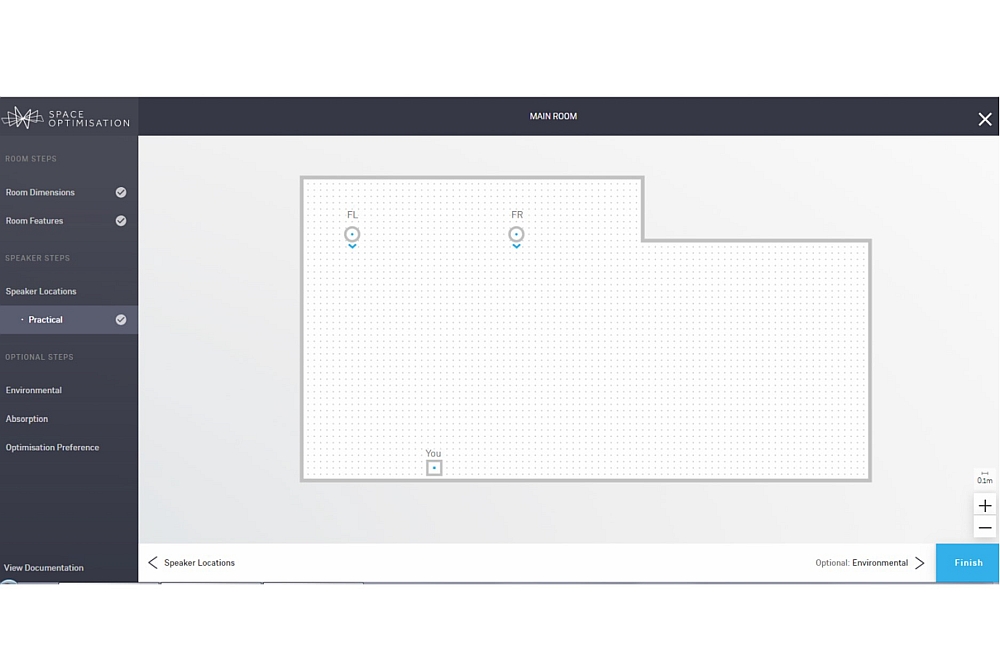 Room layout & dimensions
Room layout & dimensions
Logging into my Linn account and using the online Space Optimisation tool, I input my room layout and dimensions. In the case of open plan rooms (such as mine), all rooms opening to the main listening room should be entered as antechambers and additional cavities will add extra resonances and affect decay times. Next, I input the speaker and listening positions, followed by the environmental factors, absorption and optimisation preference. After waiting a minute or two for calibration to complete, I was presented with the recommended configuration which I accepted and saved.
Now, to get some music flowing. The Selekt is supplied with its own remote control, however, I opted to try Linn’s Kazoo app that I had just installed on my iPhone. The Kazoo app allows the Selekt DSM to access streaming services like Tidal or Qobuz, internet radio, or your NAS music library as long as you are running a compatible music server (such as Minim Server). The interface is satisfactory but nothing special and since I had satisfied myself of the functionality I switched to Roon which immediately recognised the Selekt DSM and allowed me to choose my first few tunes.
First impressions were that the music lacked a little weight. I selected Stravinsky’s The Firebird – Concert Suite for Orchestra No. 2 Finale (Elji Oue, Minnesota Orchestra, Reference Recordings), which is for me a go-to when evaluating bass response. The piece was rendered with superb clarity, the French horn section slowly emerging from a jet black background, soon joined by the harp. Everything was going swimmingly until the bass drum was struck. While technically more accurate than what I’m used to through the Spires, the pant-flapping impact was gone. I tried a few more tunes and, while I wanted to retain the improved clarity throughout the mid bass and midrange, I wasn’t sure I could be left wanting on the lower registers. I decided to re-run Space Optimisation to see if I could tweak the amount of correction.
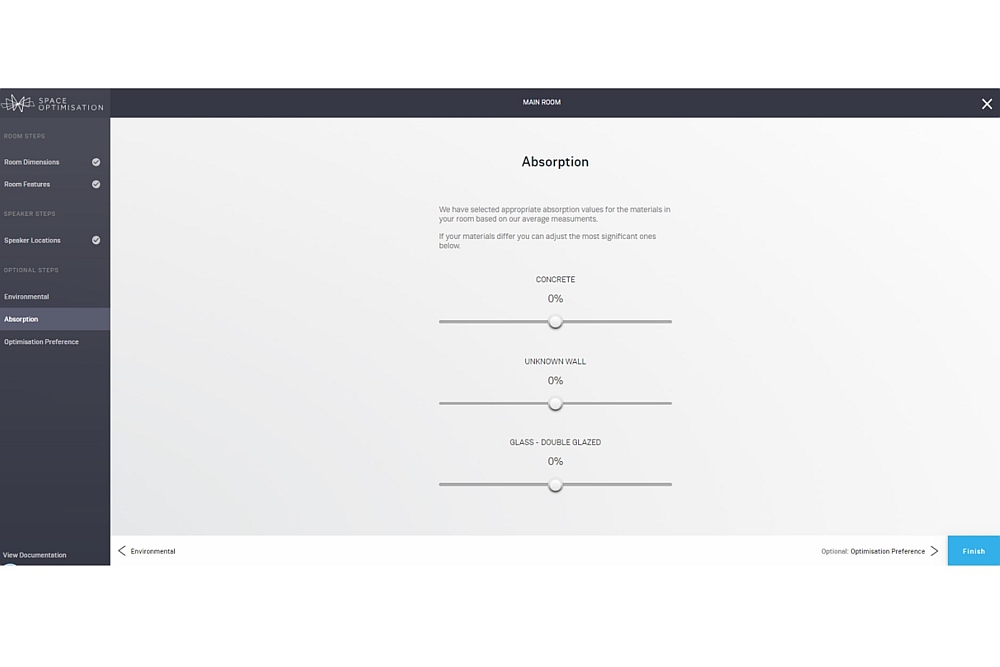 Absorption adjustability menu
Absorption adjustability menu
Space Optimisation provides two types of adjustment; the first is the ability to change the level of absorption from nearby room surfaces. Increasing the absorption will result in an optimisation that takes shallower, broader cuts at the frequencies artificially distorted by your room; decreasing the absorption will result in an optimisation that takes deeper, sharper cuts at the frequencies artificially distorted by your room.
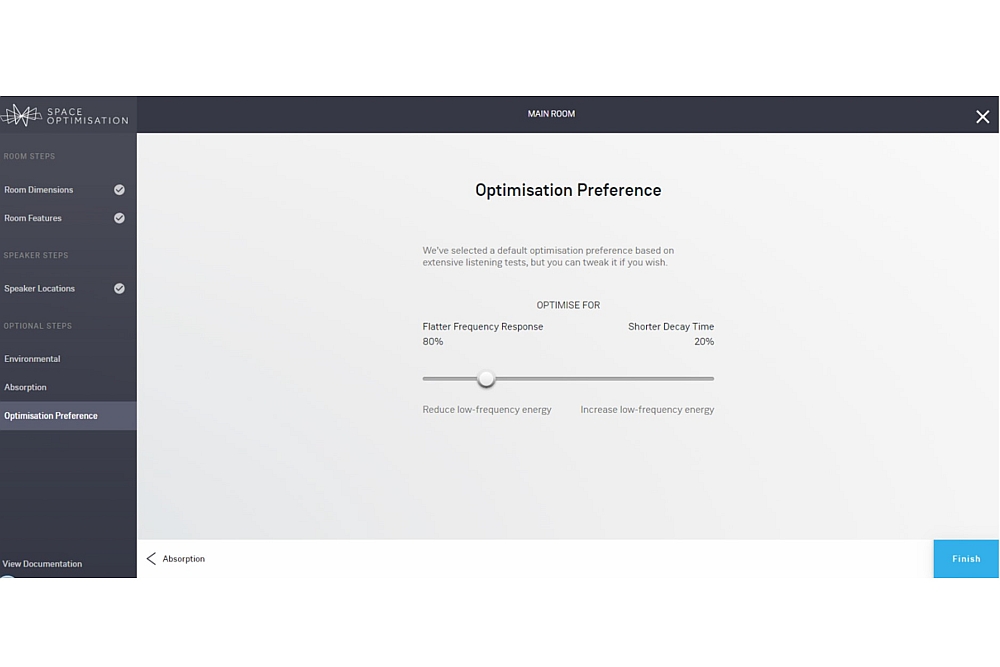 Frequency Response and Decay adjustments
Frequency Response and Decay adjustments
The second adjustment is the ability to change the Optimisation Preference which is the balance between Flat Frequency Response and Shorter Decay Time. Moving the slider toward Flatter Frequency Response will result in an optimisation that takes deeper cuts and applies less decay control at the frequencies artificially distorted by your room; moving the slider toward Shorter Decay Time will result in an optimisation that takes shallower cuts and applies more decay control at the frequencies artificially distorted by your room. It’s a simple interface which doesn’t require prior understanding of room modes and allows you to customise the level of attenuation to your preference.
After some experimentation, I tested the new settings on a number of orchestral pieces including Aaron Copland’s Fanfare for the Common Man (Telarc), and Mussorgsky’s Pictures at an Exhibition (Decca Ovation, Chicago Symphony conducted by Sir George Solti). Wow! I now felt I had a rendering which approximated my recollection of various live classical performances I’ve attended over the years.
I really dig Linn’s Tune Dem philosophy which is that “If it sounds better, it is”. Most of us can tell within the first 30 seconds whether we like one component over another and for most of us the ‘why’ is not so important. In my case I unequivocally preferred the sound through my Spires via the Selekt with Space Optimisation engaged. It was not a subtle difference and I knew it would be hard to go back…
I recently acquired Queen’s The Game (half-speed mastered by Bob Ludwig on 180g vinyl by Hollywood Records) and thought this might be a good starting point. This is without doubt the best I’ve heard Queen sound on my system. It’s a fantastic piece of vinyl with well-balanced bass, midrange and treble energy throughout each song. On “Dragon Attack” the soundstage was tight and three-dimensional, each instrument having an authentic presence. Drums were realistically sized and with natural attack and decay. Similar were bass and guitar – I could easily imagine Brian May standing in front of me.
Although Space Optimisation works only on the lower frequencies, improvements also manifest much higher up leading to more clarity and a less fatiguing presentation. Getting the bass right provides the foundation upon which all else is built. I found this benefit also adds to the portrayal of rhythm. As is described in the Tune Dem philosophy, when your system’s rendition of a tune makes you want to move – you know it’s doing something right. Try “Crazy Little Thing Called Love” from this LP via the Selekt and you’ll know what I mean.

Next up, Ray Lamontagne and the Pariah Dogs LP Godwillin’ & The Creek Don’t Rise. The ability of the MM phono stage to put together such a coherent and three-dimensional soundstage was impressive for an integrated device. The bass extension was surprising and when disengaging Space Optimisation it became completely overpowering and obscured much of the detail in the mid-bass.
Changing gears I streamed Daft Punk’s fabulous “Give Life Back to Music” from their Random Access Memories album. Here, the bass was a little less potent than I’m used to – easily resolved, however, by bumping up the volume a notch or two, bringing the overall balance to near concert levels. The Selekt responded showing minimal audible or environmental (heat) signs of distress. In my room and through the Martin Logan Spires, it could play loud and clean.
It wasn’t just Daft Punk electronica that sounded great. I also tried Deadmau5’s “Infra Turbo Pigcart Racer” from their While (1<2) album. Here, the music builds slowly emerging from the Selekt’s silent background. The bass had a ‘nail you to the wall’ punch while retaining texture elsewhere in the mix.
“Chasing Pirates” from Norah Jones’ The Fall album, courtesy of my NAS music library, was rendered beautifully. Each instrument in the mix seeming more clearly defined than I’m used to on the Spires when driven from my usual amplifier without room correction. The Katalyst DAC showed its strength here recreating Norah’s vocals and guitar with precision while leaning toward a smooth overall texture. This was reiterated on other tracks like “You’ve Ruined me Now” where Norah’s vocals stretch from almost a whisper to a shout without any undue sense of strain and with minimal compression.
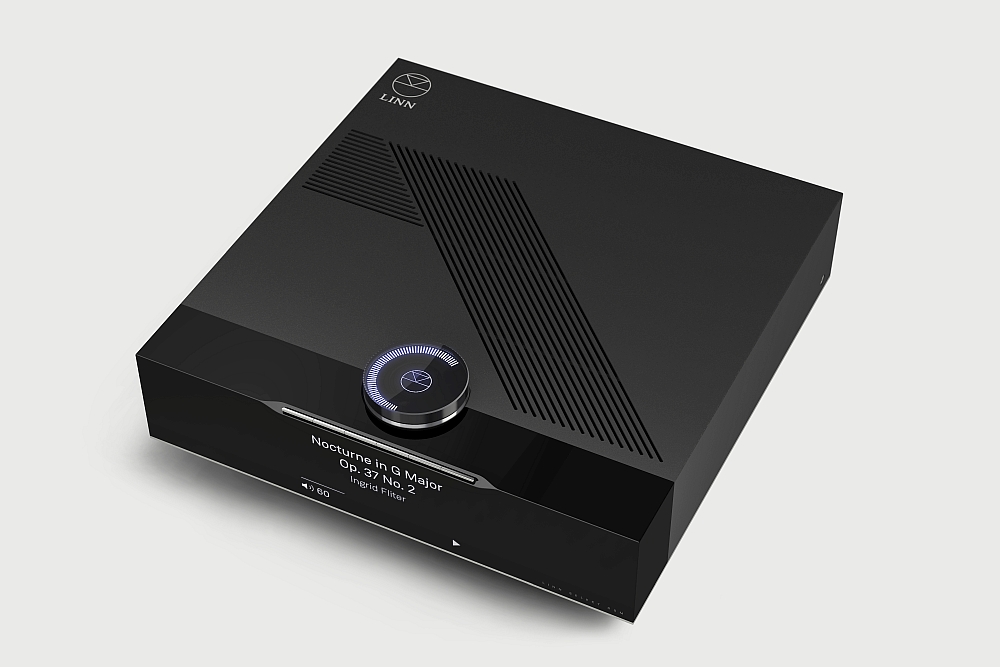
On Massive Attack’s “Live with Me” from their Collected compilation album (Tidal), Terry Callier’s vocals were thick with emotion amongst the haunting ambience of the keyboards and strings, overlayed by crisp percussion.
It’s interesting to realise how much impact the sub 100 Hz area has on the listening experience. When done correctly the ‘clutter’ is removed and the impact on the mid bass, midrange and even much further up is remarkable.
So were there any negatives? Not many. If you have very inefficient or otherwise power hungry speakers it may lack the authority and control possible from a larger amplifier, in which case the Selekt DSM without integrated amplifier could be the more appropriate option. I have heard slightly greater soundstage height and depth on the Spires but that’s being picky (perhaps a limitation in the integrated amplifier?) Lack of Wi-Fi may be an issue for some, however, Linn has Wi-Fi and Bluetooth capability planned for later this year. Headphone aficionados may be disappointed as there’s no headphone amp option currently on the roadmap.
Conclusion
Most of us are conditioned to accept a bottom end that is bloated and over-blown as normal. Those who listen to a lot of live unamplified music will quickly recognise the accuracy of Space Optimisation. For the former group Space Optimisation will take a little getting used to and the ability to fine tune the amount of compensation may ease the transition.
As a DAC, the Katalyst is superb, providing detail without aggression or harshness, and the Class-D amplifier of Linn’s own proprietary design proved quite capable of driving my Spires to decent volume levels. Its performance belies the power rating of 100Wpc into 4 ohms and 50Wpc into 8 ohms. This one-box solution rendered music with far more realism than my traditional setup. Removing the deleterious effects of the listening environment is (like correctly positioning your speakers) one of the biggest improvements one can make to a system.
The Selekt is a seriously great audio component. For music lovers who are over (or never got into) constant tweaking it offers a level of performance that is frighteningly close to far more expensive (and space consuming) equipment, something I find very appealing.
… Barry Jones
www.soundstageaustralia.com
NOTE – This review was made possible via a review sample kindly provided by Dubai Audio, www.dubaiaudio.com
Associated Equipment
- Speakers — MartinLogan Spire
- Amplifier — Perreaux e250i 40th Anniversary Edition integrated amplifier
- Sources — Digital: Lumin T1, Oppo BDP-105D, Sonos ZP90. Analogue: Rega RP6 turntable, Rega Exact-2 cartridge, Rega Aria phono stage & Rega Couple interconnects
- Processor — DEQX HDP-5
- DAC/Headphone Amplifier — Chord Mojo DAC
- Headphones — AudioQuest Nighthawk
- Cables — Nordost White Lightning, Kimber Cable Timbre balanced and Van Den Hul D-300III unbalanced interconnects, Atlas Compass Digital Coaxial Audio Cable, QED Performance Graphite USB
- Miscellaneous — Isotek Sirius Power Conditioner, custom made bass traps in front wall corners
Linn Selekt DSM + Katalyst Network Music Player
Price: AU$13,995 as reviewed (starting at AU$7995 for line only version)
Warranty: Five Years
Australian Distributor: Advance Audio Australia
+61 2 9561 0799
www.advanceaudio.com.au
Linn Products Ltd
Glasgow Road, Waterfoot
Glasgow G76 0EQ
Scotland
+44 (0) 141 307 7777
www.linn.co.uk






